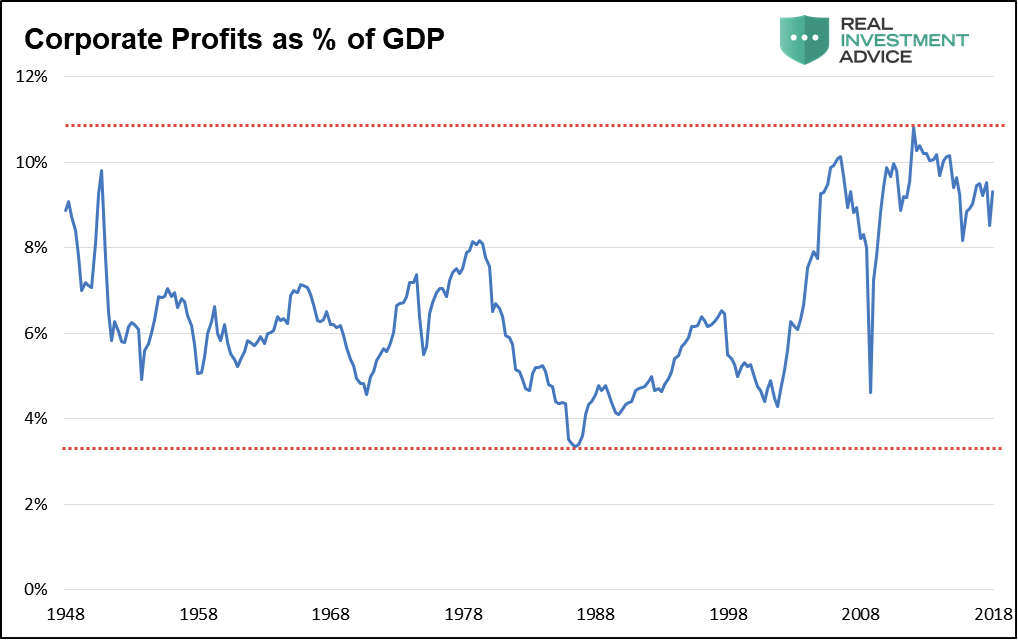“Better to paralyzed from the neck down than the neck up.” – Charles Krauthammer
It is easy to be upbeat about the stock market.
Currently, as the second quarter earnings are being released, the S&P 500 (NYSEARCA:SPY) is expected to post a second consecutive quarter of earnings growth in excess of 20%.
The first two quarters of 2018 will show the strongest two consecutive quarters of growth since 2010, when earnings were recovering from the fallout of the financial crisis. The recent strength in corporate profits is attributable, in large part, to the federal tax overhaul late last year, but there are other factors contributing as well.
The U.S. economy is showing strength, employment data remains strong and consumer spending is upbeat.
Although recent economic output has been encouraging, the Federal Reserve and other forecasters expect it to slow once again as the effects of recent policy pass through the system. In other words, the profit growth from tax reductions is a one-time benefit. It lacks sustainability and comes with the additional challenge of higher levels of government debt in the long-run.
The current expansion has defied all critics and now stands as the second longest in post-WWII history. Somewhat counter-intuitively, this is not a point of encouragement. The reason is that, over the long-term, aggregate earnings can only grow as fast as sales and sales growth is typically similar to that of the growth of the economy overall. So, to draw on the wisdom of Milton Friedman, earnings cannot break loose from economic gravity. Using that fundamental logic as a common-sense guide and cautiously assuming consensus growth forecasts are in the ball park, corporate profits likely peaked in the first half of 2018.
Wall Street forecasters often get caught up in the new narrative flavor of the month and decide somehow that the laws of financial physics should be suspended. Forecasting earnings growth that constantly exceeds sustainable GDP growth is, of course, preposterous. Furthermore, stock markets allow us to participate in the growth of existingenterprises, but GDP growth is also comprised of the creation of new enterprises through entrepreneurial capitalism.
Based on that important dynamic, real corporate earnings and dividends should grow at roughly half the rate of economic growth. As you can see, proper consideration of these facts raises important and serious questions about both earnings and equity valuations.
Nobody likes to see a good party end, but when hard-earned wealth is at risk, it is probably a good idea to heed warnings and protect current gains. Earnings will revert back to their true (meaning pre-tax reduction) growth rate, which will obviously limit future equity gains. Despite an economy that has struggled to grow much above 2%, U.S. corporations have enjoyed a remarkably long period of support through zero-interest-rate-policy (ZIRP), low labor costs, and a weak U.S. dollar. If we can agree that there is no such thing as a free lunch, there is a cost to those benefits and it appears to be showing up in populism.
That introduces a variety of important uncertainties regarding policy and financial circumstances. For a more thorough analysis on these issues please read The Uncivil Civil War.
If we are to evaluate equities in accordance with their duration as an asset (30+ years), then one time benefits lasting a quarter or two should be properly discounted and put in context of the longer term picture. As the valuation sirens are wailing, like at other former peaks, equity investors and the market are guilty of neglect.
Twitter: @michaellebowitz
Any opinions expressed herein are solely those of the author, and do not in any way represent the views or opinions of any other person or entity.









